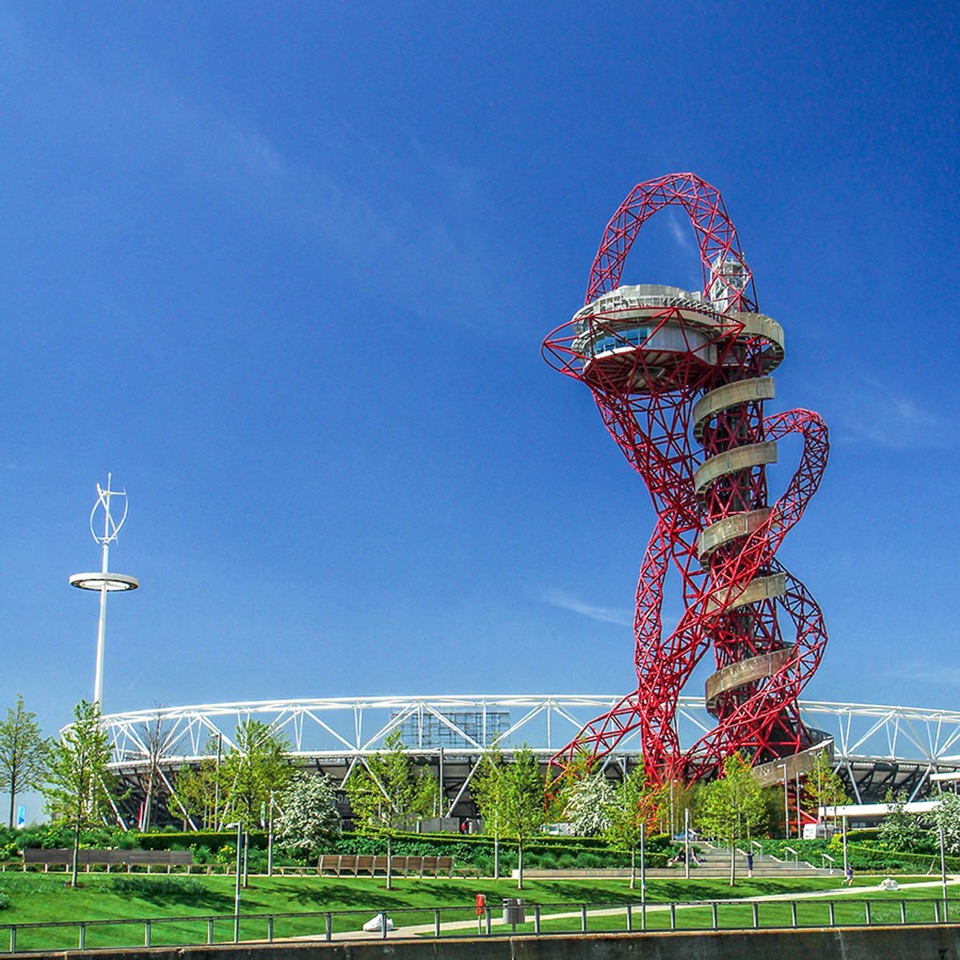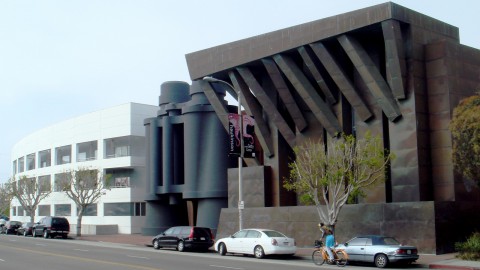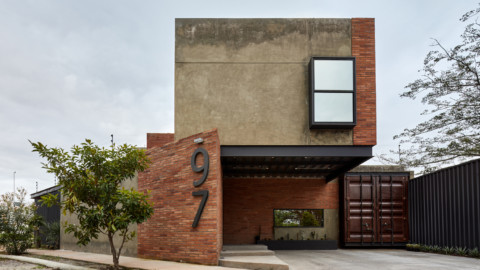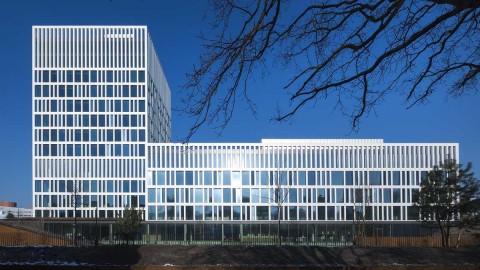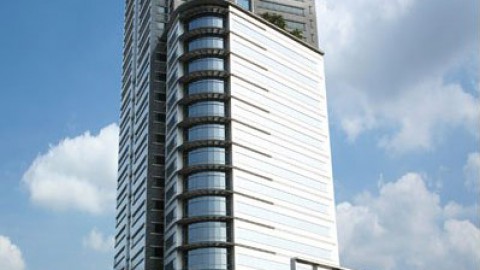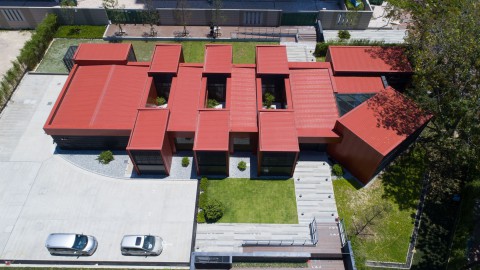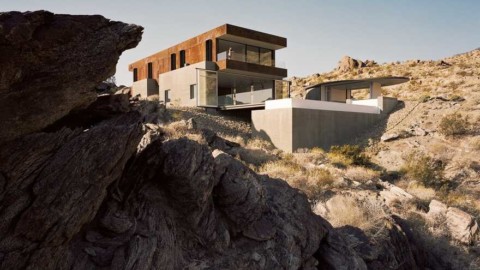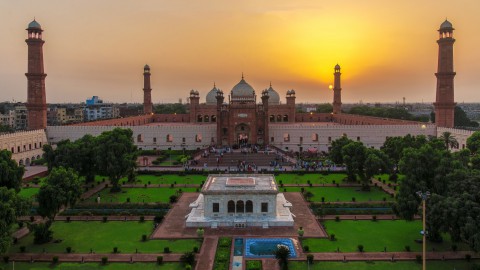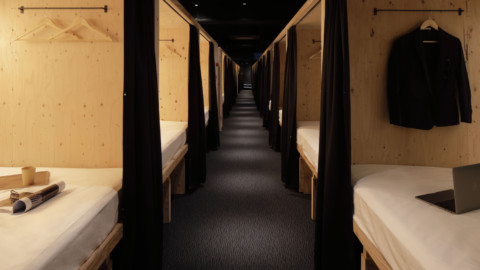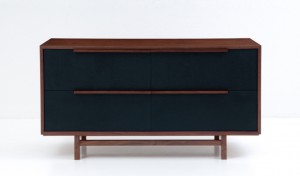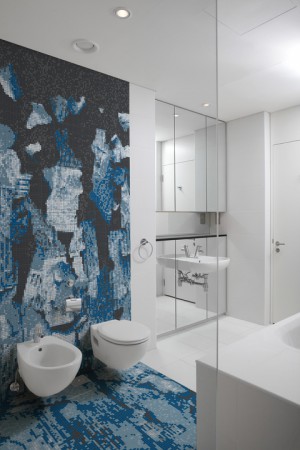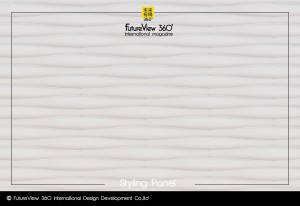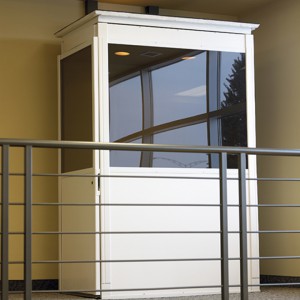ArcelorMittal Orbit 安賽樂米塔爾軌道
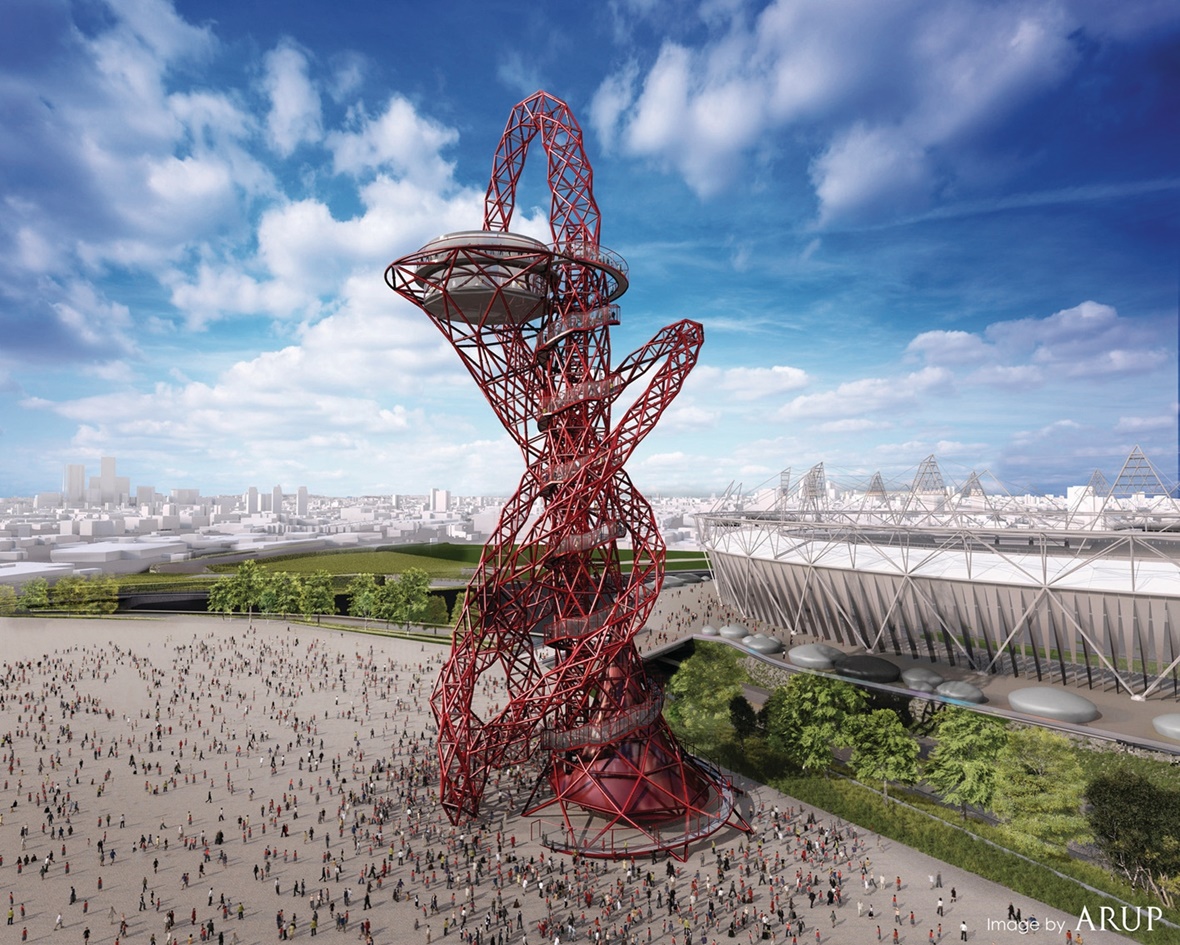
The ArcelorMittal Orbit (often referred to as the Orbit Tower or its original name, Orbit) is a 114.5-metre-high sculpture and observation tower in the Queen Elizabeth Olympic Park in Stratford, London. It is Britain’s largest piece of public art, and is intended to be a permanent lasting legacy of London’s hosting of the 2012 Summer Olympic and Paralympic Games, assisting in the post-Olympics regeneration of the Stratford area. Sited between the Olympic Stadium and the Aquatics Centre, it allows visitors to view the whole Olympic Park from two observation platforms.
Orbit was designed by Turner-Prize winning artist Sir Anish Kapoor and Cecil Balmond of engineering Group Arup. Announced on 31 March 2010, it was expected to be completed by December 2011. The project came about after Mayor of London Boris Johnson and Olympics Minister Tessa Jowell decided in 2008 that the Olympic Park needed “something extra”. Designers were asked for ideas for an “Olympic tower” at least 100 metres (330 ft) high, and Orbit was the unanimous choice from proposals considered by a nine-person advisory panel. Kapoor and Balmond believed that Orbit represented a radical advance in the architectural field of combining sculpture and structural engineering, and that it combined both stability and instability in a work that visitors can engage with and experience via an incorporated spiral walkway. It has been both praised and criticised for its bold design, and has especially received criticism as a vanity project of questionable lasting use or merit as a public art project.
The project was expected to cost £19.1 million, with £16 million coming from Britain’s then richest man, the steel tycoon Lakshmi Mittal, Chairman of the ArcelorMittal steel company, and the balance of £3.1 million coming from the London Development Agency. The name “ArcelorMittal Orbit” combines the name of Mittal’s company, as chief sponsor, with Orbit, the original working title for Kapoor and Balmond’s design.
The ArcelorMittal Orbit closed after the 2012 Olympic and Paralympic Games, while the South Plaza area of the Park (in which Orbit is positioned) underwent reconstruction for its long-term legacy use as a public outdoor space. It re-opened to the public on 5 April 2014. The structure incorporates the world’s tallest and longest (178 metres) tunnel slide, designed by Carsten Höller. The idea was originally envisioned by the London Legacy Development Corporation as a way to attract more visitors to the tower. The slide includes transparent sections to give a “different perspective” of the twisting red tower and was completed in June 2016. This follows an option to abseil down the tower, which was introduced in 2014.
ArcelorMittal軌道(通常被稱為Orbit Tower或其原名Orbit)是一座114.5米高的雕塑和觀景塔,位於倫敦斯特拉特福德的伊麗莎白女王奧林匹克公園內。它是英國最大的公共藝術作品,旨在成為倫敦舉辦2012年夏季奧運會和殘奧會的永久遺產,為斯特拉特福德地區的奧運會後重建做出貢獻。它位於奧林匹克體育場和水上運動中心之間,可以讓遊客從兩個觀景台觀看整個奧林匹克公園。
Orbit由Turner-Prize獲獎藝術家Sir Anish Kapoor和工程集團Arup的Cecil Balmond設計。該項目於2010年3月31日公佈,預計將於2011年12月完成。該項目是在倫敦市長鮑里斯·約翰遜和奧運會部長泰莎·喬威爾於2008年決定奧林匹克公園需要“額外的東西”之後實現的。設計師被要求提供至少100米(330英尺)高的“奧林匹克塔”的想法,而Orbit是一個九人諮詢小組考慮的建議的一致選擇。卡普爾和巴爾蒙德認為,Orbit代表了雕塑和結構工程相結合的建築領域的一個根本性進步,它將穩定性和不穩定性結合在一起,遊客可以參與並通過一個融合的螺旋走道進行體驗。它以其大膽的設計受到了讚揚和批評,並且特別受到批評,認為它是一個虛構的項目,具有可疑的持久使用或作為公共藝術項目的功績。
該項目預計耗資1,910萬英鎊,其中1600萬英鎊來自英國當時的首富,鋼鐵大亨Lakshmi Mittal,ArcelorMittal鋼鐵公司主席,以及來自倫敦發展署的310萬英鎊餘額。 “ArcelorMittal Orbit”這個名字將米塔爾公司的名稱與作為主要贊助商的Orbit結合起來,這是Kapoor和Balmond設計的原始工作頭銜。
安賽樂米塔爾軌道在2012年奧運會和殘奧會結束後關閉,而公園的南廣場區域(軌道所在的位置)進行了重建,以作為公共室外空間的長期遺留用途。它於2014年4月5日重新向公眾開放。該結構採用了由CarstenHöller設計的世界上最高,最長(178米)的隧道滑道。這個想法最初是倫敦遺產開發公司設想的,旨在吸引更多遊客前往塔樓。幻燈片包括透明部分,以提供扭曲的紅色塔的“不同視角”,並於2016年6月完成。這是在2014年推出的下降塔的選擇。
General information
Type:Observation tower
Location:Queen Elizabeth Olympic Park
London, E20
United Kingdom
Coordinates:51°32′18″N 0°0′48″WCoordinates: 51°32′18″N 0°0′48″W
Estimated completion:May 2012
Opened:April 2014
Cost:£22.7 million
Owner:Olympic Park Legacy Company (on completion), ownership transferred to London Legacy Development Corporation
Management:Balfour Beatty Workplace on behalf of London Legacy: Development Corporation
Height:114.5 m (376 ft)
Technical details
Floor area:300 m2 (3,229 sq ft)
Design and construction
Architect:Designed by Anish Kapoor with Sir Cecil Balmond of engineering Group Arup, architect Ushida Findlay Architects
Developer:Arcelor Mittal and London Development Agency
Structural engineer:Arup
一般信息
類型:觀察塔
地點:英國女王伊麗莎白公園
倫敦,E20
英國
坐標:51°32’18“N 0°0’48”W坐標:51°32’18“N 0°0’48”W
預計完成時間:2012年5月
開業時間:2014年4月
費用:2270萬英鎊
所有者:奧林匹克公園遺產公司(建成後),所有權轉讓給倫敦遺產開發公司
管理層:Balfour Beatty Workplace代表London Legacy:Development Corporation
高度:114.5米(376英尺)
技術細節
建築面積:300平方米(3,229平方英尺)
設計和施工
建築師:由Anish Kapoor和工程集團Arup的Sir Cecil Balmond,建築師Ushida Findlay Architects設計
開發商:Arcelor Mittal和倫敦發展署
結構工程師:Arup
According to London mayor Boris Johnson, in around October 2008 he and Tessa Jowell decided that the site in Stratford, London that was to become the Olympic Park for the 2012 Olympics needed “something extra” to “distinguish the East London skyline”, and “arouse the curiosity and wonder of Londoners and visitors”.
A design competition held in 2009 called for designs for an “Olympic tower”. It received about 50 submissions. Johnson has said that his early concept for the project was something more modest than Orbit, along the lines of “a kind of 21st-century Trajan’s Column”, but this was dropped when more daring ideas were received.
The media reported unconfirmed details of the project in October 2009, describing the interest of the steel magnate Lakshmi Mittal, one of Britain’s richest men, in funding a project that would cost around £15 million. Boris Johnson was believed to want something like the Eiffel Tower or the Statue of Liberty. At that time there were understood to be five short-listed artists, including Antony Gormley, being considered. Early designs reportedly included ‘Transmission’ by Paul Fryer, a 400 feet (120 m) high structure “resembling a cross between a pylon and a native American totem pole”, according to The Times. A spokesman for Johnson would only confirm that he was “keen to see stunning, ambitious, world-class art in the Olympic Park”, and that work on commissioning the project was at an early stage.
Mittal’s involvement came about after a chance meeting with Johnson in a cloakroom in Davos in January 2009, as they were on their way to separate dinner engagements. In a conversation that reportedly lasted 45 seconds Johnson pitched the idea to Mittal, who immediately agreed to supply the steel. Mittal later said of his involvement, “I never expected that this was going to be such a huge project. I thought it was just the supply of some steel, a thousand tonnes or so, and that would be it. But then we started working with artists and I realised that the object was not just to supply steel but to complete the whole project. It took us almost 15 months of negotiation and discussion.” Johnson has said that, “In reality, ArcelorMittal has given much more than the steel.”
Kapoor’s and Balmond’s Orbit was announced as the winner on 31 March 2010. According to The Guardian, Orbit was chosen from a short list of three, beating a design by Antony Gormley and one by the architectural firm Caruso St John. According to The Times, Gormley’s design was a 390 feet (120 m) steel colossus titled Olympian Man, a trademark piece of a statue of himself, rejected mainly on the grounds of its projected cost, estimated at £40 million.
Johnson and Jowell agreed to issue a commission for Orbit in partnership with Mittal after it was chosen by a 9 person advisory panel brought together by them to advise on a long list of proposals. According to Mittal, the panel made a unanimous decision to pick Orbit, as it both represented the Olympic Games and was achievable within the ambitious time frame. Kapoor described it as “the commission of a lifetime”.
Johnson pre-empted possible criticism during the official launch by stating: “Of course some people will say we are nuts – in the depths of a recession – to be building Britain’s biggest ever piece of public art. But both Tessa Jowell and I are certain that this is the right thing for the Stratford site, in Games time and beyond.”
The completed structure was officially unveiled to the press and public on 11 May 2012.
The structure was re-purposed with the world’s longest slide in 2016, as a way to attract more visitors.
根據倫敦市長鮑里斯·約翰遜的說法,他和Tessa Jowell在2008年10月左右決定在倫敦斯特拉特福德成為2012年奧運會奧林匹克公園的網站需要“額外的東西”以“區分東倫敦的天際線”,“引起倫敦人和遊客的好奇心和奇蹟“。
2009年舉行的設計競賽要求設計“奧林匹克塔”。它收到了大約50份意見書。約翰遜已經表示,他早期的項目概念比“軌道”更為溫和,與“21世紀的圖拉真專欄”一致,但是當收到更多大膽的想法時,這一點就被取消了。
媒體在2009年10月報導了該項目的未經證實的細節,描述了英國最富有的鋼鐵巨頭拉克希米米塔爾(Lakshmi Mittal)為一項耗資約1500萬英鎊的項目提供資金的興趣。據信鮑里斯·約翰遜想要像埃菲爾鐵塔或自由女神像這樣的東西。當時有人認為有五位入圍藝術家,包括安東尼·戈姆利,正在考慮中。據“泰晤士報”報導,早期的設計據稱包括Paul Fryer的“傳輸”,這是一個400英尺(120米)高的結構,“類似於塔架和美國本土圖騰柱之間的交叉”。約翰遜的發言人只會證實他“渴望在奧林匹克公園看到令人驚嘆的,雄心勃勃的,世界一流的藝術品”,並且該項目的委託工作尚處於初期階段。
米塔爾的參與是在2009年1月在達沃斯的一個衣帽間與約翰遜偶然會面之後發生的,因為他們正在分開晚餐活動。在據報導持續45秒的談話中,約翰遜向米塔爾提出了這個想法,米塔爾立即同意供應鋼鐵。米塔爾後來談到了他的參與,“我從未預料到這將是一個如此巨大的項目。我認為這只是一些鋼鐵的供應,一千噸左右,就是這樣。但是後來我們開始工作了。與藝術家和我意識到,對像不僅僅是提供鋼材,而是完成整個項目。我們花了將近15個月的談判和討論。“約翰遜曾說過,“實際上,安賽樂米塔爾給予的不僅僅是鋼鐵。”
2010年3月31日,卡普爾和巴爾蒙德的軌道被宣佈為獲勝者。據“衛報”報導,Orbit從三個短名單中選出,擊敗Antony Gormley的設計和建築公司Caruso St John的設計。根據泰晤士報的報導,Gormley的設計是一個390英尺(120米)的鋼鐵巨人,名為Olympian Man,是他自己雕像的一個商標,主要以其預計成本為由拒絕,估計為4000萬英鎊。
Johnson和Jowell同意與Mittal合作發行Orbit委員會,之後由他們召集的9人諮詢小組選出,以便提供一長串建議。根據米塔爾的說法,該小組一致決定選擇Orbit,因為它既代表了奧運會,也是在雄心勃勃的時間框架內實現的。卡普爾將其描述為“一生一世的使命”。
約翰遜在官方發布會上強調可能受到批評:“當然有些人會說,在經濟衰退的深處,我們正在建設英國有史以來規模最大的公共藝術品。但是泰莎·喬威爾和我都確定在奧運會期間及以後,這對斯特拉特福德網站來說是正確的。“
已完工的建築於2012年5月11日正式向新聞界和公眾揭幕。
該結構重新定位於2016年世界上最長的滑坡,以吸引更多遊客。
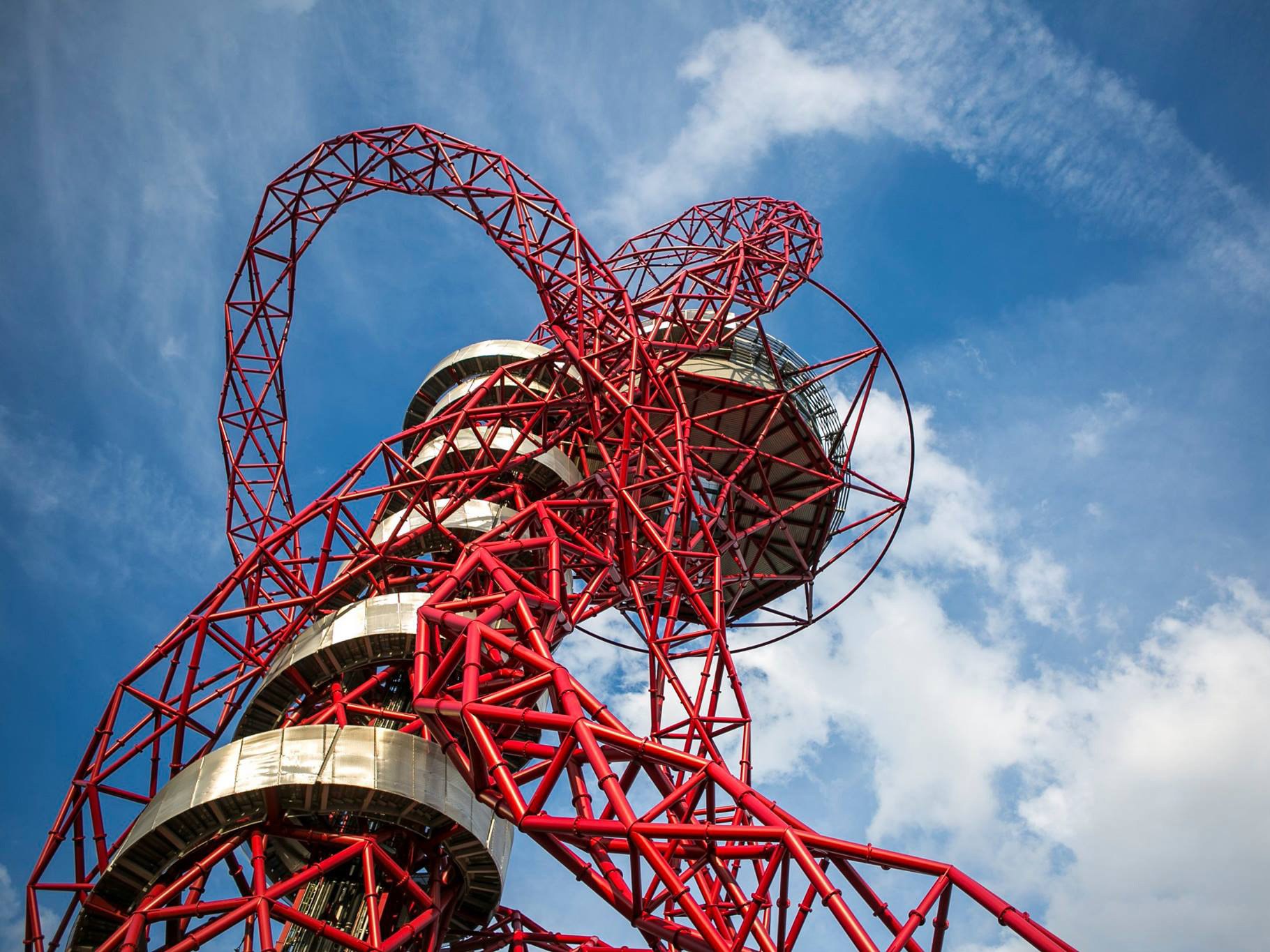
Design
Interpretation
According to Kapoor, the design brief from the Mayor’s office was for a “tower of at least 100 metres (330 ft)”, while Balmond said that he was told the Mayor was “looking for an icon to match the Eiffel Tower”.
Kapoor said that one of the influences on his design was the Tower of Babel, the sense of “building the impossible” that “has something mythic about it.”, and that the form “straddles Eiffel and Tatlin”. Balmond, working on the metaphor of an orbit, envisaged an electron cloud moving, to create a structure that appears unstable, propping itself up, “never centred, never quite vertical”. Both believe that Orbit represents a new way of thinking, “a radical new piece of structure and architecture and art” that uses non-linearity – the use of “instabilities as stabilities.” The spaces inside the structure, in between the twisting steel, are “cathedral like”, according to Balmond, while according to Kapoor, the intention is that visitors will engage with the piece as they wind “up and up and in on oneself” on the spiral walkway.
The Independent described Orbit as “a continuously looping lattice … made up of eight strands winding into each other and combined by rings like a jagged knot”. The Guardian describes it as a “giant lattice tripod sporting a counterweight collar around its neck designed to offset the weight of its head, a two-storey dining and viewing gallery”. According to the BBC, the design incorporates the five Olympic rings.
Upon its launch Johnson said “It would have boggled the minds of the Romans. It would have boggled Gustave Eiffel.” Nicholas Serota, a member of the design panel, said that Orbit was a tower with an interesting twist, with “the energy you might traditionally associate with this type of structure but in a surprisingly female form”.
Name
According to Mittal, Orbit was already the working title, as it symbolised a continuous journey, a creative representation of the “extraordinary physical and emotional effort” that Olympians undertake in their continuous drive to do better. It was decided to keep this as the final name and prepend ArcelorMittal (as the project supporter).
On the public announcement of the design Johnson conceded that it might become known by something other than its official name, suggesting “Colossus of Stratford” or the “Hubble Bubble”, in reference to his belief that it resembles a giant shisha pipe, or a variant on people’s perceptions that it resembled a “giant treble clef”, a “helter-skelter”, or a “supersized mutant trombone”.
設計
解釋
根據卡普爾的說法,市長辦公室的設計簡報是“至少100米(330英尺)的塔”,而巴爾蒙德說他被告知市長“正在尋找一個與埃菲爾鐵塔相匹配的圖標”。
卡普爾說,他設計的影響之一就是巴別塔,“建造不可能”的感覺,“它有一些神話般的東西。”,形式“橫跨埃菲爾和塔特林”。研究軌道隱喻的巴爾蒙德設想了一個電子云運動,創造一個看起來不穩定的結構,支撐自己,“從不居中,從不完全垂直”。兩人都認為Orbit代表了一種新的思維方式,即“一種全新的結構,建築和藝術”,它使用非線性 – 使用“不穩定性作為穩定性”。根據Balmond的說法,結構內部的空間,在扭曲的鋼之間,是“大教堂般的”,而根據卡普爾的說法,意圖是遊客將隨著他們“上升和上升”自己的風而參與其中。螺旋走道。
“獨立報”將軌道描述為“一個連續循環的格子……由八股股線相互纏繞而成,並由一個像鋸齒狀結一樣的環組合而成”。 “衛報”將其描述為“巨型格子三腳架,在其頸部設有配重項圈,旨在抵消其頭部的重量,一個兩層樓的餐廳和觀景廊”。據英國廣播公司報導,該設計融合了五個奧運五環。
約翰遜在發布會上說:“這會讓羅馬人的思緒難以理解。這會讓古斯塔夫·艾菲爾斯難以置信。”設計小組成員尼古拉斯·塞羅塔(Nicholas Serota)表示,Orbit是一座有趣的塔樓,“傳統上你可以將這種結構與這種類型的結構聯繫起來,但卻以令人驚訝的女性形式”。
名稱
根據米塔爾的說法,Orbit已經成為了工作頭銜,因為它像徵著一個持續的旅程,是奧林匹克運動員在不斷努力做得更好的過程中所做的“非凡的身體和情感努力”的創造性代表。決定將此作為最終名稱並加入ArcelorMittal(作為項目支持者)。
在設計的公開宣布中,約翰遜承認,除了正式名稱之外,它可能會被稱為“斯特拉特福巨像”或“哈勃泡泡”,這是因為他認為它類似於一個巨大的水煙管,或者人們認為它類似於“巨型高音譜號”,“笨蛋”或“超大型突變長號”的變體。
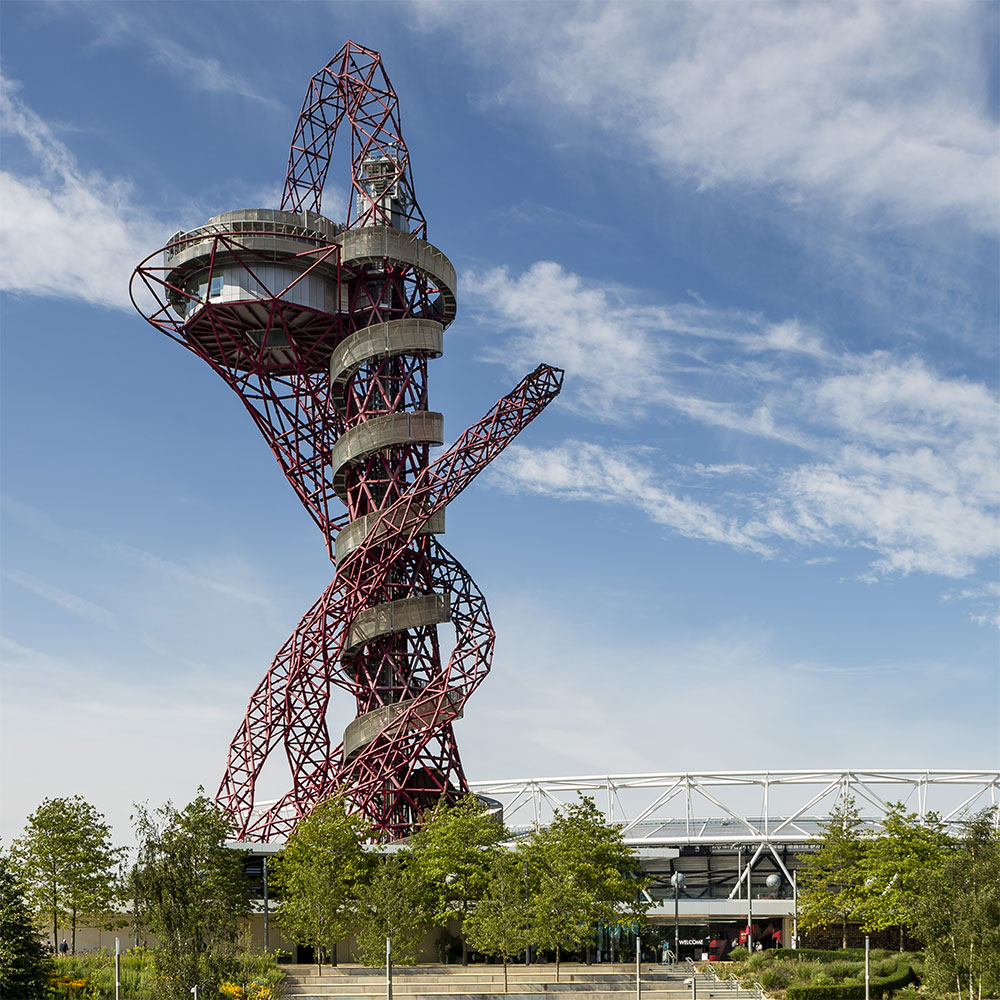
Designers
Orbit is described as “designed by Anish Kapoor and Cecil Balmond”. Kapoor is a Turner Prize winning sculptor, while Balmond is one of the world’s leading designers. According to Kapoor, both men are “interested in a place where architecture meets sculpture” and “the way that form and geometry give rise to structure”. Kapoor and Balmond stated that their interests have blurred and crossed over into each other’s fields, since they had first begun working together in 2002 on Kapoor’s Marsyas installation in the Turbine Hall of the Tate Modern. As well as Orbit, in 2010 Kapoor and Balmond were also working on the Tees Valley Giants, a public art project in northern England.
The sculpture was engineered by the Global engineer Arup who developed the overall geometry, structural design and the building services including the lighting displayed extensively during the Olympic games. Architectural input was by Ushida Findlay Architects(Kathryn Findlay) as a sub-consultant to Arup. Findlay’s work made the sculpture into a functional building, for example designing the staircase.
設計師
軌道被描述為“由Anish Kapoor和Cecil Balmond設計”。卡普爾是特納獎獲獎雕塑家,而巴爾蒙德則是世界頂級設計師之一。根據卡普爾的說法,兩人都“對建築與雕塑相遇的地方感興趣”和“形式和幾何形成結構的方式”。卡普爾和巴爾蒙德表示他們的興趣已經模糊並交叉到彼此的領域,因為他們在2002年首次開始合作,在泰特現代美術館渦輪大廳的卡普爾Marsyas裝置。與Orbit一樣,2010年Kapoor和Balmond也在Tees Valley Giants工作,這是一個位於英格蘭北部的公共藝術項目。
該雕塑由全球工程師Arup設計,他開發了整體幾何,結構設計和建築服務,包括在奧運會期間廣泛展示的照明。建築投入由Ushida Findlay Architects(Kathryn Findlay)擔任Arup的副顧問。芬德利的工作使雕塑成為一個功能性建築,例如設計樓梯。
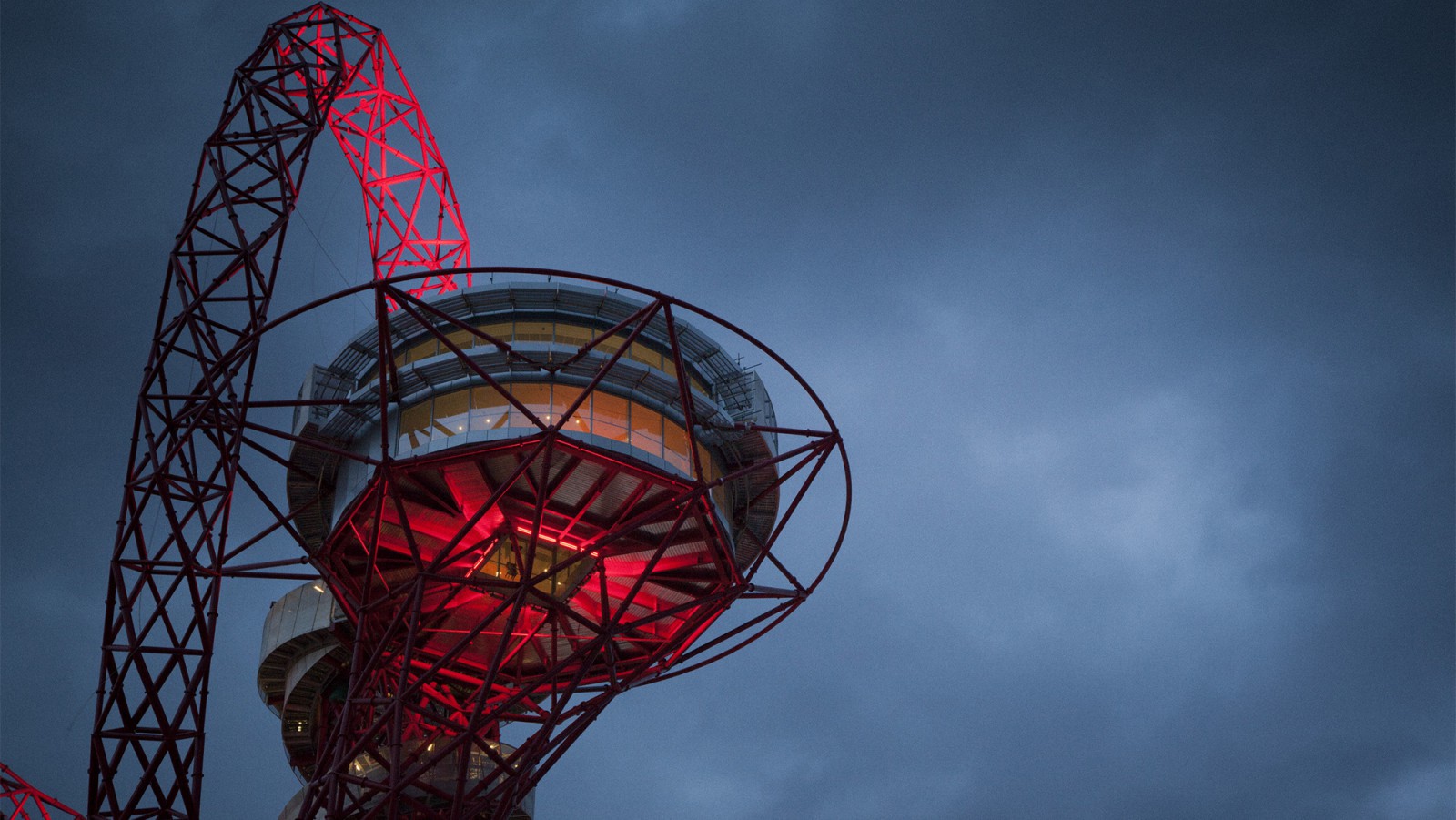
Structural
The organic design of Orbit means that an extraordinary amount of work was necessary on structural engineering. This was done by Arup, which reported that it took up two-thirds of the budget for the project (twice the percentage normally allotted to structural engineering in a building project).
From a structural point of view, Orbit consists of two parts:
the trunk – the more-or-less vertical tower which houses the elevators and stairs and supports the observation deck.
the red tube – an open lattice of red steel that surrounds the trunk.
The trunk has a base diameter of 37 metres (121 ft), narrowing to 5 metres (16 ft) on the way up, then widening again to 9.6 metres (31 ft) just under the observation deck. The trunk is supported and stabilized by the tube, which gives a structural character of a tripod to the entire construction. Further structural integrity is given to the construction by octagonal steel rings that surround the tube and trunk, spaced at 4 metres (13 ft) and cross-joined pairwise by sixteen diagonally mounted steel connectors.
A special part of the construction is the canopy, the conic shape that hangs off the bottom of the trunk. Originally planned as a fibreglass composite construction, costs forced the use of steel for this section as well. Centraalstaal was approached as a special consultant for the design of the steel cone and came up with a design for a cone built out of 117 individually shaped steel panels with a total surface area of 586 square metres. The entire cone weighs 84 tonnes.
Height
Early contradictory reports suggested the tower would be 120 metres (390 ft) tall. However, it finally measured in at 114.5 metres (376 ft) making it the UK’s tallest sculpture surpassing “Aspire” (at 60m).
The Greater London Authority on announcing the project described Orbit’s height in comparison with the Statue of Liberty, stating that it would be 22 metres (72 ft) taller – the Statue of Liberty is 93 metres (305 ft) high, including the 46 metres (151 ft) statue and its pedestal. While the media picked up the apparent intention to cast the Orbit as London’s answer to the Eiffel Tower, The Guardian related how it was “considerably shorter” than that Parisian icon; the Eiffel Tower is 324 metres (1,063 ft) tall. The Guardian also noted that, with respect to comparisons to the Eiffel Tower, it is even “20 metres (66 ft) shorter than the diminutive Blackpool Tower”.
Its height was also compared in the media with other London landmarks. It was described as being “slightly taller” or “nearly 20 metres (66 ft) taller” than the Big Ben clock tower, the centrepiece of the Palace of Westminster. It was also described as being “twice as tall” or “more than double the height” of Nelson’s Column, the monument honouring Admiral Nelson in Trafalgar Square. Others reports described how it was “just short of” or “almost as tall as” the Great Pyramid of Giza in Egypt, the ancient tomb of the Pharaoh Khufu. Big Ben is 96.3 metres (316 ft) tall, Nelson’s Column is 51.5 metres (169 ft) tall, including statue and column. The Giza Pyramid was thought to have been constructed as 280 Egyptian cubits or 146.478 metres (480.57 ft) tall, although with erosion it has reduced in height by nearly 10 metres.
結構
Orbit的有機設計意味著結構工程需要大量的工作。這是由Arup完成的,據報導,它佔用了該項目預算的三分之二(通常分配給建築項目中結構工程的百分比的兩倍)。
從結構的角度來看,Orbit由兩部分組成:
行李箱 – 或多或少的垂直塔架,可容納電梯和樓梯,並支撐觀景台。
紅色的管子 – 圍繞著行李箱的紅色鋼鐵的開放格子。
行李箱的底座直徑為37米(121英尺),在向上行駛時縮小至5米(16英尺),然後在觀景台下方再次擴寬至9.6米(31英尺)。軀幹由管支撐並穩定,這為整個結構提供了三腳架的結構特徵。通過圍繞管和主幹的八邊形鋼環進行結構的進一步結構完整性,間隔4米(13英尺)並通過十六個對角安裝的鋼連接器成對交叉連接。
建築的一個特殊部分是頂篷,圓錐形狀懸掛在樹幹的底部。最初計劃作為玻璃纖維複合材料結構,成本也迫使該部分使用鋼材。 Centraalstaal被聘為鋼錐設計的特別顧問,並設計了一個由117個獨立形狀的鋼板構成的錐形設計,總面積為586平方米。整個錐體重84噸。
高度
早期矛盾的報告顯示塔高120米(390英尺)。然而,它最終在114.5米(376英尺)處測量,使其成為英國最高的雕塑,超過“Aspire”(60米)。
大倫敦管理局在宣布該項目時描述了Orbit與自由女神像相比的高度,稱其高度為22米(72英尺) – 自由女神像高93米(305英尺),包括46米( 151英尺)雕像及其基座。雖然媒體明顯意圖將“軌道”作為倫敦對埃菲爾鐵塔的回答,但“衛報”講述了它如何比“巴黎”圖標“短得多”;埃菲爾鐵塔高324米(1,063英尺)。 “衛報”還指出,就與埃菲爾鐵塔的比較而言,它甚至比“小型布萊克浦塔”短20米(66英尺)。
它的高度也在媒體上與其他倫敦地標進行了比較。它被描述為比大本鐘鐘樓“高一點”或“高近20米(66英尺)”,這是威斯敏斯特宮的核心。它也被描述為納爾遜紀念柱的“兩倍高”或“超過兩倍高度”,紀念碑是在特拉法加廣場紀念尼爾森海軍上將。其他報導描述了它是如何“只是”或“幾乎與埃及吉薩大金字塔一樣高”,這是法老胡夫的古墓。大本鐘高96.3米(316英尺),尼爾森柱高51.5米(169英尺),包括雕像和柱子。據認為,吉薩金字塔的建造高度為280埃及肘,高146.478米(480.57英尺),雖然受到侵蝕,但高度減少了近10米。
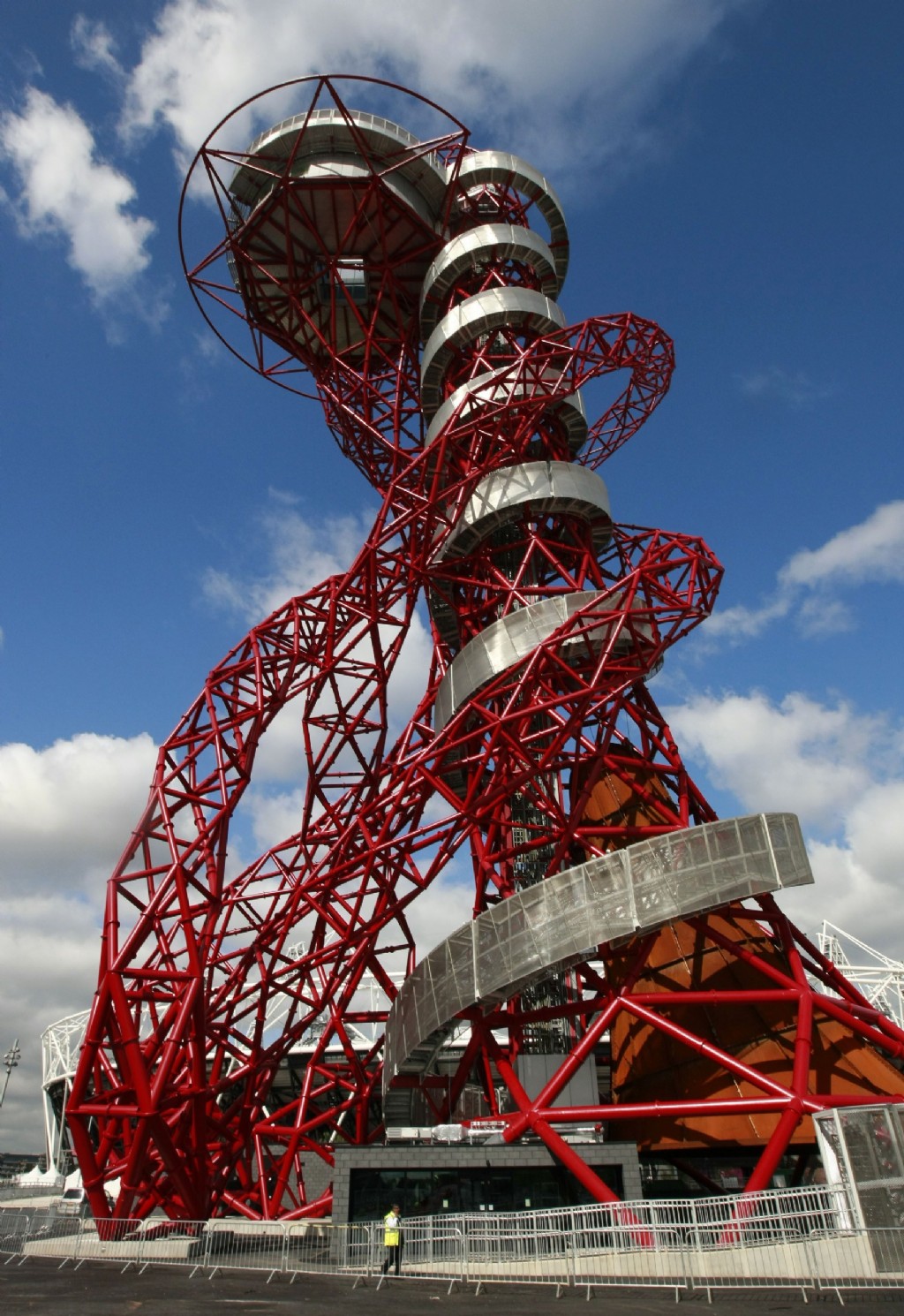
Construction
Orbit is located in the southern area of the Olympic Park, between Olympic Stadium and the Aquatics Centre. After the March 2010 confirmation of Orbit as the winning design, construction began in November 2010 and it reached its full height in November 2011.
Steel is the primary material used in the sculpture. According to Balmond, there was no other feasible alternative, as steel was the only material that could give the minimum thickness and maximum strength represented in the coiling structure. It was built from approximately 2000 tons of steel, produced as much as possible from ArcelorMittal plants, with the exact sourcing being determined by the grades of steel required and the technical requirements of the project. 60% of the steel used for the sculpture was made of recycled steel in the Esch Belval steel plant in Luxembourg.
On 14 March 2011, with construction already underway on the main pylon, The One Show broadcast footage of the on-site status of project, and profiled the four-man team putting it together, comprising two steel erectors, a crane operator and a site foreman.
施工
Orbit位於奧林匹克公園的南部地區,位於奧林匹克體育場和水上運動中心之間。在2010年3月確認Orbit作為獲獎設計後,2010年11月開始施工,並於2011年11月達到全高。
鋼是雕塑中使用的主要材料。根據Balmond的說法,沒有其他可行的替代方案,因為鋼是唯一能夠提供捲繞結構中所代表的最小厚度和最大強度的材料。它由大約2000噸鋼製成,盡可能從安賽樂米塔爾工廠生產,確切的採購量取決於所需的鋼種和技術要求。在盧森堡的Esch Belval鋼廠,用於雕塑的鋼材中有60%是由再生鋼製成的。
2011年3月14日,主塔上已經開始施工,The One Show播放了項目現場狀態的視頻,並介紹了將四人組合在一起的四人團隊,其中包括兩台鋼製安裝工,一台起重機操作員和一個工地領班。
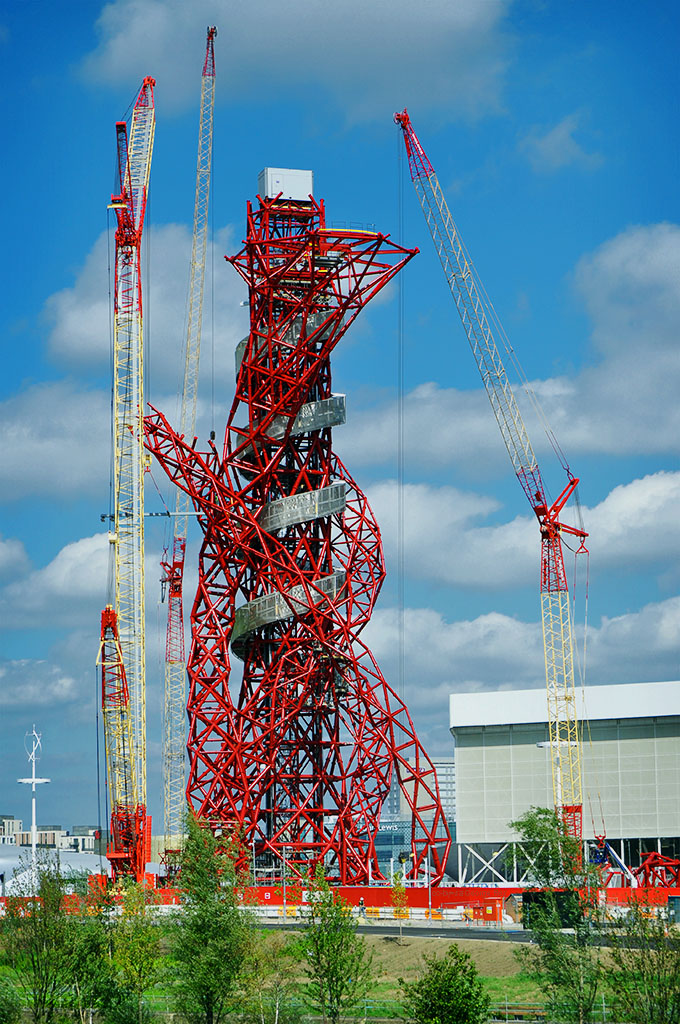

FROM:https://en.wikipedia.org/wiki/ArcelorMittal_Orbit
FROM:The Slide at the ArcelorMittal Orbit
FROM:The world’s tallest slide
FROM:ArcelorMittal Orbit
Don’t you think it’s addictive?
Want to know more about the beauty of architecture?
Come and join our members to explore the beauty of architectural design.
覺得看得不過癮嗎?
想要知道更多建築之美嗎?
快來加入我們的會員,一同探索建築設計之美。
The above article is purely for appreciation and sharing purposes, as well as the construction of new technology and the public can be in-depth understanding of the information at the same time there are sources, will be able to query, no use of the document as a commercial transaction, if illegal, please inform the We will immediately remove the site, thank you for cooperation.
以上文章純粹作為欣賞及分享用途,以及將建築新型技術傳遞給與大眾能夠深入了解,同時資料還有來源,將可查詢,絕無使用該文件資料作為商業交易行為,如有違法請務必告知該網站我們將立即處理撤除,謝謝合作。

